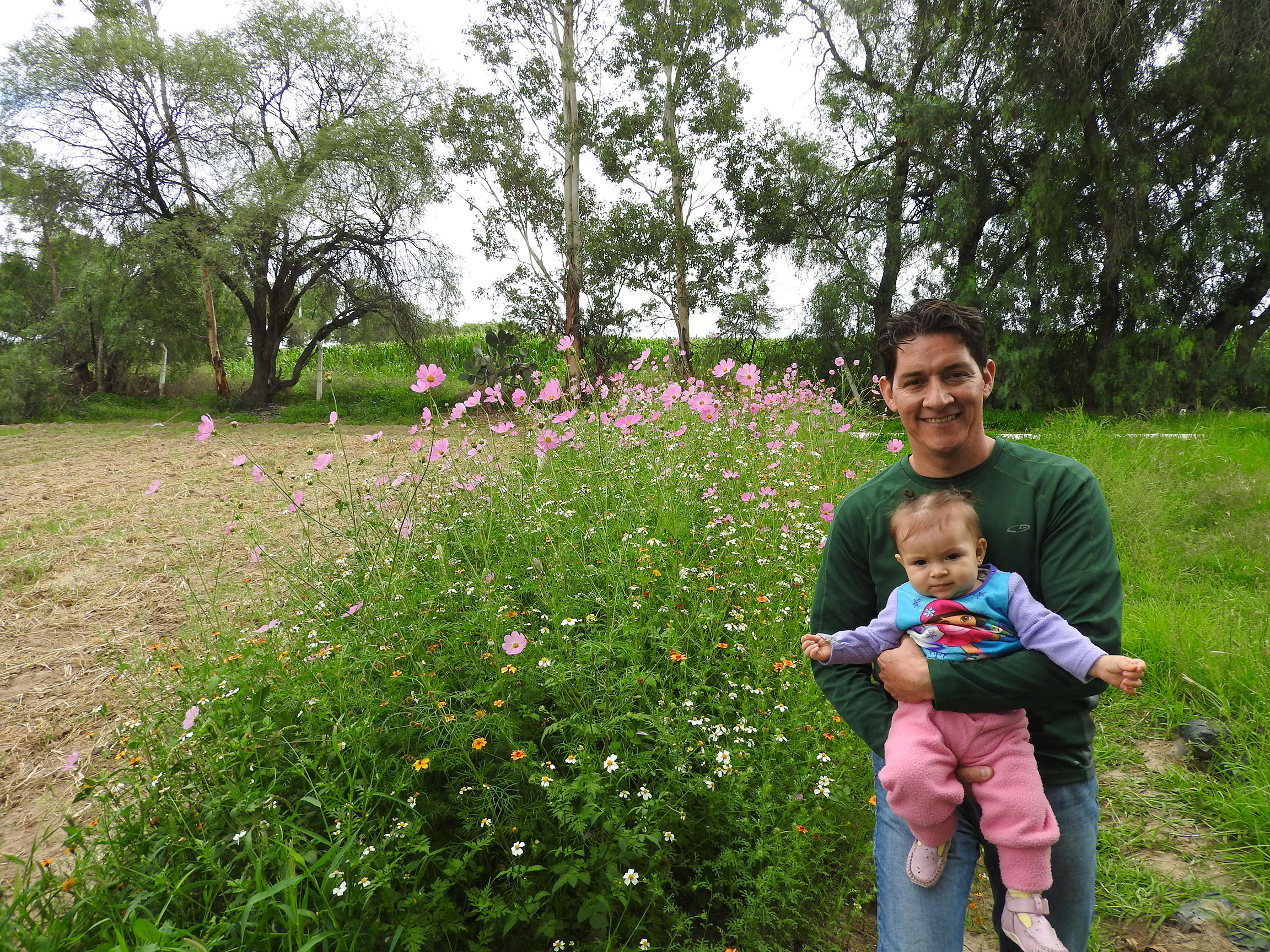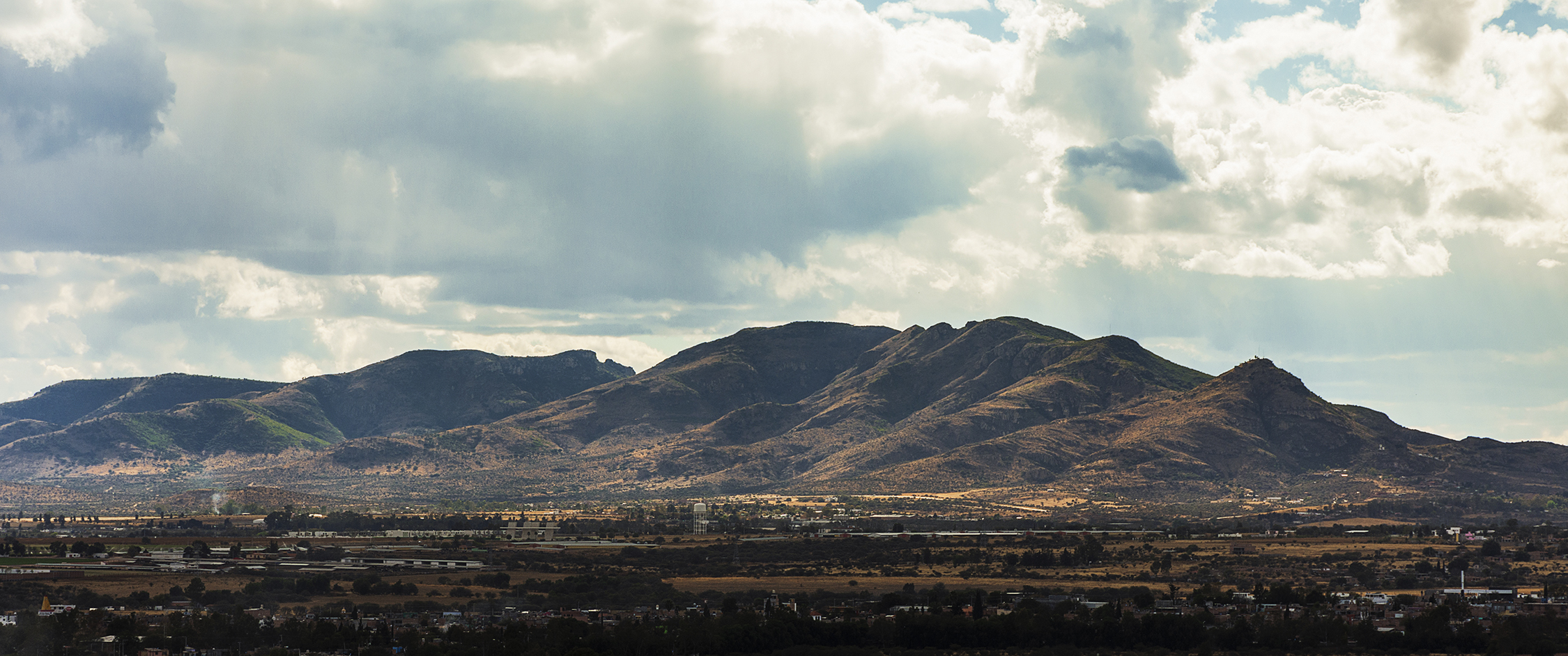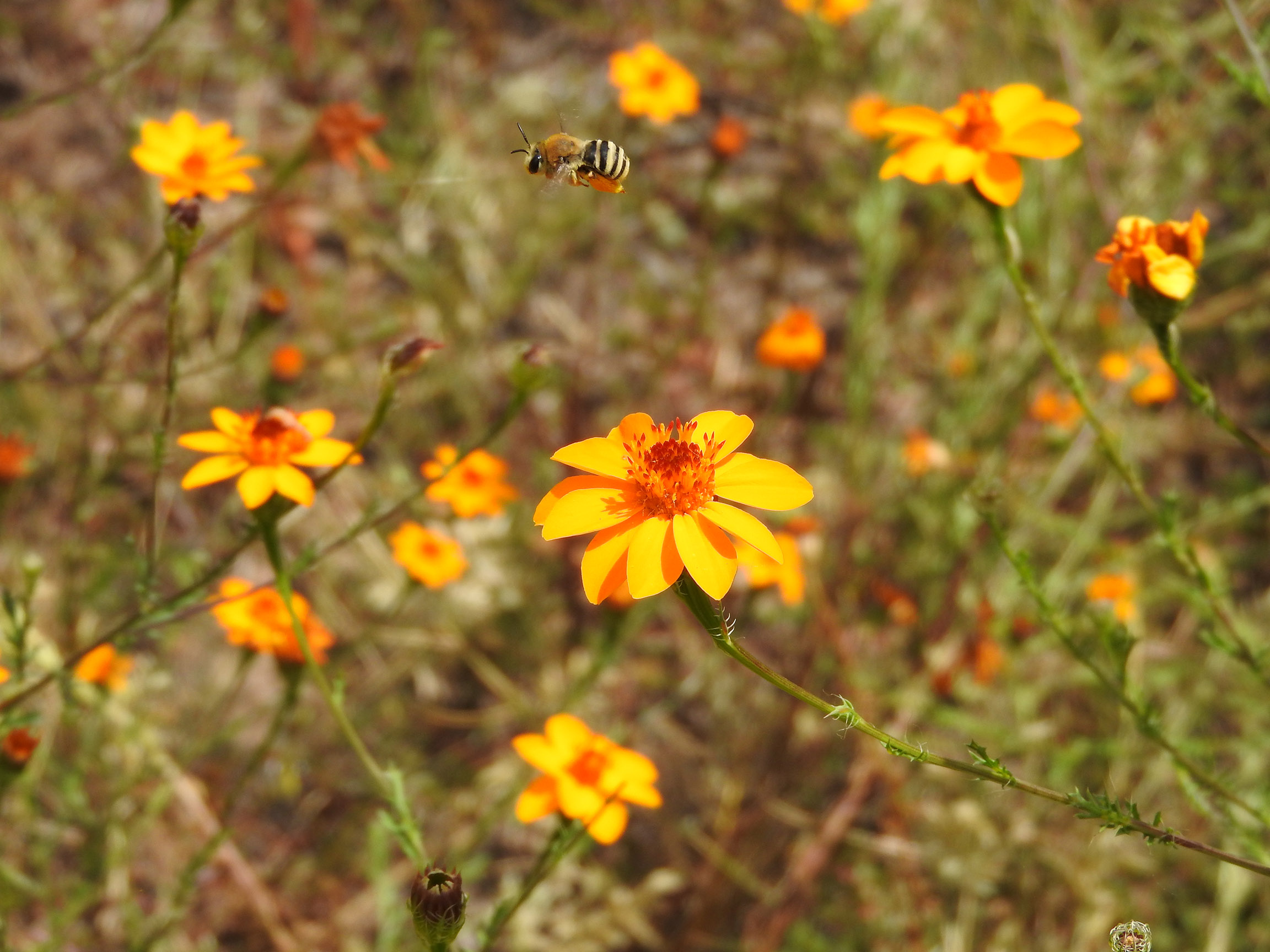Durante los últimos años, el personal de la Sociedad Xerces ha tenido el placer de apoyar a Héctor Ávila Villegas en sus esfuerzos por promover espacios naturales que sirvan de hábitat para los polinizadores y de difusión de su conservación en el estado de Aguascalientes, México. En una serie de dos partes, estamos publicando este blog escrito por Héctor, donde describe su trabajo hasta ahora y sus planes a futuro. Esta es la primera parte. (Para leer la segunda parte, haga click aquí.)El blog es bilingüe (español e inglés). Stephanie Frischie, especialista en plantas nativas de la Sociedad Xerces, realizó la traducción.
Over the last couple of years, Xerces Society staff have had the pleasure of supporting Héctor Ávila Villegas with his efforts to promote naturalized spaces that function as pollinator habitat and outreach in the state of Aguascalientes, Mexico. We are publishing a two-part blog written by Héctor that describes his work so far and his plans for the future. This is part one. (To read part two, click here.)The translation (see below Spanish text) was done by Stephanie Frischie, Native Plant Materials Specialist for the Xerces Society.
Crecí entre los paisajes del desierto chihuahuense—donde abundaban los nopales, los tepozanes y los mezquites—y los edificios coloniales, calles empedradas y cielos azules de la ciudad de Zacatecas en el centro de México. Las plantas y los animales estuvieron siempre presentes cuando era niño. Mi papá (médico especialista) decoraba la mesa del comedor con pequeños racimos de flores silvestres dentro de un vaso con agua; mi mamá (actualmente médico retirado) disfrutaba de tostar semillas de calabaza y café, y mi hermano mayor (ahora biólogo de la conservación con The Sierra Club) imaginaba que tenía un león en nuestro patio trasero. Terminé mis estudios de biología en la Universidad Autónoma de Aguascalientes en el año 2000 y en 2005 obtuve mi grado de maestro en ciencias en el Centro de Investigaciones Biológicas del Noroeste, S.C. en La Paz, Baja California Sur, donde trabajé con la serpiente de cascabel de la Isla Santa Catalina (Crotalus catalinensis).

Héctor Ávila Villegas es un biólogo de la conservación que trabaja en la creación de espacios naturales con plantas nativas para la conservación de los polinizadores en el centro de México.
Tengo que admitir que el zumbido de una abeja en mi oreja me provoca más escozor que el sonido de una serpiente de cascabel en el suelo. Aun así, mi interés por los polinizadores ha crecido durante los últimos años, porque he entendido que conservándolos se puede beneficiar a todo el ecosistema, a otras especies y a las actividades humanas que allí se realizan. Mi relación con los polinizadores inició en 2015, cuando participé con ECOSISTEMICA, A.C., una asociación dedicada a la conservación, en la creación de jardines para polinizadores en beneficio de la mariposa monarca en el centro de México. Dos años después, con el apoyo del Gobierno del Estado de Aguascalientes, desarrollé un proyecto mediante el que se entregaron a apicultores locales más de 6 mil bombas de semillas de plantas nativas benéficas para las abejas y otros polinizadores. En 2018 elaboré una colección personal de semillas de plantas nativas y realicé varias acciones de educación sobre polinizadores. En 2019, con la asesoría de la Sociedad Xerces, elaboré
Me encantan las flores silvestres, mi favorita es Cosmos; el modo de vida y la diversidad de las abejas nativas me parecen sorprendentes. Me interesa continuar creando hábitat para polinizadores en el centro de México, en superficies amplias, como áreas de cultivo, granjas solares, áreas de restauración, etc., así como continuar realizando acciones de educación sobre su importancia y conservación.

El “Cerro del muerto” es la montaña más emblemática de Aguascalientes, con vegetación representativa como matorral espinoso, pastizal y bosque de encino. (Foto: Fundación Sierra Adentro / Gabriel Sánchez Ávila.)
En Dónde Vivo y mi Visión de la Situación Local de los Polinizadores
Aguascalientes se localiza en la parte central de México. Su nombre se debe a la abundancia de “ojos” de aguas termales que aquí existían. Es el cuarto estado más pequeño del país donde existen matorrales, mezquitales, pastizales y bosques templados, y se realizan actividades de agricultura y ganadería.
Creo que en Aguascalientes la conservación de los polinizadores enfrenta importantes retos. Aunque poco a poco se empieza a reconocer la importancia de las abejas para los ecosistemas y la producción de alimentos, solamente se habla de las abejas de la miel (Apis mellifera) y se sabe poco o nada sobre las abejas nativas. Por ejemplo, una iniciativa de ley estatal de protección de las abejas, lamentablemente únicamente hace referencia a las abejas de la miel.
Por otra parte, no existen estudios formales ni hay investigadores locales que estén trabajando en conocer la diversidad y biología de las abejas nativas, aunque se tiene mayor conocimiento sobre las mariposas y polillas, gracias a los trabajos de investigadores de la Universidad Autónoma de Aguascalientes.
Finalmente, la creación de hábitat para los polinizadores se empieza a realizar mediante el uso de flores ornamentales en jardines y huertos de la ciudad. Sin embargo, no existen iniciativas para la creación de hábitat en superficies amplias. Por esta razón es que inicié el proyecto para la creación de praderas con flores silvestres en Aguascalientes y el centro de México.

Una abeja nativa (Tetralloniela sp.) se mueve entre las flores de alcanfor (Adenophyllum porophyllum var. radiatum) que crecen durante la temporada de lluvias de verano en Aguascalientes. (Foto: Héctor Ávila Villegas.)
Elaboración de la primera franja de hábitat para polinizadores
Con el propósito de aprender cómo realizar todos los pasos para hacer una franja de flores silvestres, decidí empezar a pequeña escala. Entendí que necesitaba un lugar que tuviera suficiente espacio abierto, donde la franja de flores estuviera resguardada y donde yo pudiera acceder con frecuencia. Fue así que, a principios del 2019, le propuse el proyecto a mi amigo, el Ing. Francisco Javier Hernández Dueñas, un profesor retirado del Departamento de Agronomía de la Universidad de Aguascalientes, con quien había trabajado en el 2011, que cuenta con una granja familiar que tiene todas estas características (la granja El Rosario) y quien se mostró entusiasmado con el proyecto.
Para empezar, colocamos un plástico transparente para invernadero en una superficie de 25 metros cuadrados (270 ft2) durante dos meses (abril–mayo), para esterilizar el suelo mediante solarización. Mientras esto ocurría, entré en contacto con la Sociedad Xerces, que por conducto de Stephanie Frischie, me acompañó y asesoró durante todo el proceso de elaboración de la franja.
A principios de junio, cuando empieza la temporada de lluvias en el centro de México, con el apoyo de Mario y Julio Albizo, trabajadores de la granja, sembramos una mezcla de nueve especies de flores nativas que colecté el año anterior y las cubrimos con paja.

Después de sembrar al voleo una mezcla de semillas de flores silvestres y aserrín, colocamos una capa de paja molida para proteger las semillas y ayudar a guardar la humedad en el terreno. (Foto: Guadalupe Morales Díaz de León.)
Ese 2019 las lluvias se retrasaron, sin embargo, la granja El Rosario cuenta con pozo, por lo que dimos riegos dos veces a la semana durante los primeros meses hasta que llegaron las lluvias. A finales de julio, aparecieron las primeras plántulas y tres meses después de la siembra, la franja quedó totalmente cubierta por las plantas, aunque aún sin flores. Octubre fue el mes durante el que la franja estuvo más llena de flores y de polinizadores. Adicionalmente, en la franja de flores silvestres colocamos el letrero “Pollinator Habitat” de la Sociedad Xerces y construimos refugios para abejas nativas en troncos.
A partir de noviembre, cuando bajan las temperaturas en Aguascalientes, las plantas comenzaron a secarse y pudimos recuperar muchas semillas.

Vista de la franja con flores en la granja El Rosario, Aguascalientes, México. (Foto: Héctor Ávila Villegas.)
Nota del editor: Esta es la primera de dos partes en que se dividirá el blog. En la segunda, Héctor hablará de sus esfuerzos de difusión sobre polinizadores y de sus proyectos a futuro.
Conserving Pollinators in Aguascalientes, Mexico
I grew up among the landscapes of the Chihuahuan desert—picture prickly pear cacti, the endemic butterflybush, Buddleja cordata, and mesquite trees—and the colonial buildings, cobbled streets, and blue skies of the city of Zacatecas in central Mexico. Plants and animals were a constant when I was a child. My dad (a specialist doctor) decorated the dining room table with small bunches of wildflowers in glasses of water; my mom (also a doctor, but now retired) enjoyed roasting pumpkin seeds and coffee; and my older brother liked to pretend he had a lion in our backyard (he is now a conservation biologist with the Sierra Club). Fast forward to 2000 and I was finishing my biology degree at the Autonomous University of Aguascalientes. This was followed by a time spent studying the Santa Catalina Island rattlesnake (Crotalus catalinensis) for my Master of Science, which I received in 2005 from the Centro de Investigaciones Biológicas del Noroeste, S.C. in La Paz, Baja California Sur.

Héctor Ávila Villegas is a conservation biologist working to promote pollinator habitat and outreach in central Mexico.
Truth be told, the buzzing of a bee raises the hair on the back of my neck more than the sound of a rattlesnake’s rattle. Even so, my interest in pollinators has grown in recent years as I have come to understand that what is good for pollinators is good for the surrounding ecosystem, other species, and human activities.
My relationship with pollinators began in 2015, when I worked with the conservation nonprofit ECOSISTEMICA, A.C., to create pollinator and monarch gardens in central Mexico. Two years later, with support from the government of the State of Aguascalientes, I led a project that provided local beekeepers with a total of six thousand seed bombs of native plants that are beneficial to bees and other pollinators. In 2018, I began my own collection of native plant seeds and held several pollinator educational events. In 2019, with technical assistance from the Xerces Society, I planted the first pollinator habitat, a strip of native plants, at a farm called “El Rosario”, owned by a retired professor from the local university.
I love wildflowers; my favorite is cosmos (Cosmos bipinnatus), which is native to this part of Mexico. I’m astounded by the diversity and biology of native bees. I want to continue to create habitat for pollinators in central Mexico, over larger areas, such as agricultural fields, solar farms, and restored natural areas and to complement the habitat work with educational programming about the importance of pollinator conservation.

The "Cerro del Muerto" is the most emblematic mountain in Aguascalientes, with representative vegetation such as thorny scrub, grassland and oak forest. (Photo: Fundación Sierra Adentro / Gabriel Sánchez Ávila.)
Pollinators Where I Live
Aguascalientes is a city in the state of the same name, located in central Mexico. Aguascalientes literally means “hot waters” and refers to the abundance of hot springs that existed here. The primary natural vegetation types are shrublands, mesquite woodlands, and grasslands. There are also some temperate forests, as well as land used for crop and livestock production.
Pollinator conservation faces some fundamental challenges in Aguascalientes state. Although the importance of bees to ecosystems and food production is gradually being recognized, the focus is on the European honey bee (Apis mellifera), while little or nothing is known about native bees. For example, a state initiative to protect bees unfortunately only refers to honey bees.
There are currently no formal research programs, nor any local scientists, working to understand the diversity and biology of native bees. There is some knowledge about our local butterflies and moths, thanks to the work of researchers from the Autonomous University of Aguascalientes.
Beyond the pollinators themselves, pollinator habitat is being created in city gardens and orchards with ornamental flowers. However, there are no initiatives to create large-scale habitat with native local plants. This led me to start a project to create grasslands with native flowers in Aguascalientes and central Mexico.

A native bee (Tetralloniela sp.) moves among the poreleaf dogweed (Adenophyllum porophyllum var. radiatum) flowers that grow during the summer rainy season in Aguascalientes. (Photo: Héctor Ávila Villegas.)
Creating my First Wildflower Patch for Pollinator Habitat
In order to learn how to go through all the steps to establish wildflower habitat, I decided to start small. I knew that I needed a place that was open and sunny, yet protected. It also needed to be a place that I would be able to easily and frequently visit. In early 2019, I pitched the project to my friend,
To begin, we used solarization to sterilize the soil and kill weed seeds. This was done by covering an area of about 25 square meters (270 ft2) with clear greenhouse plastic and leaving it for two months (April–May). During this period, I reached out to the Xerces Society and began working with Stephanie Frischie, who provided technical support for preparing and planting the wildflower patch. I had already collected the seeds from nine species of native flowers the previous year. These were planted with the help of farm workers Mario and Juli Albizo in early June, the beginning of the rainy season in central Mexico. We broadcast the seeds over the prepared soil and covered them with straw to keep them in place and to retain soil moisture.

After broadcasting a mixture of wildflower seeds and sawdust, we added a loose layer of straw to protect the seeds and help retain moisture for their germination. (Photo: Guadalupe Morales Díaz de León.)
Despite our thoughtful planning, the rains were late in 2019. Fortunately, there is a well at the El Rosario farm and we were able to irrigate twice a week during the first months until the rainy season arrived. In late July, the first seedlings appeared and a few weeks later the patch was completely covered by the plants, although still without flowers. By October, the habitat was full of flowers and pollinators. Additionally, we built shelters of logs for native bees and put a Xerces Society "Pollinator Habitat" sign in the strip of wildflowers.
With the change of seasons and cooler temperatures in November, the plants began to die back naturally and we collected seeds from them for future use.

View of the pollinator habitat at El Rosario farm, Aguascalientes, Mexico. (Photo: Héctor Ávila Villegas.)
Editor’s note: This is the first of two installments. Héctor describes his outreach work and future plans in a second blog.



